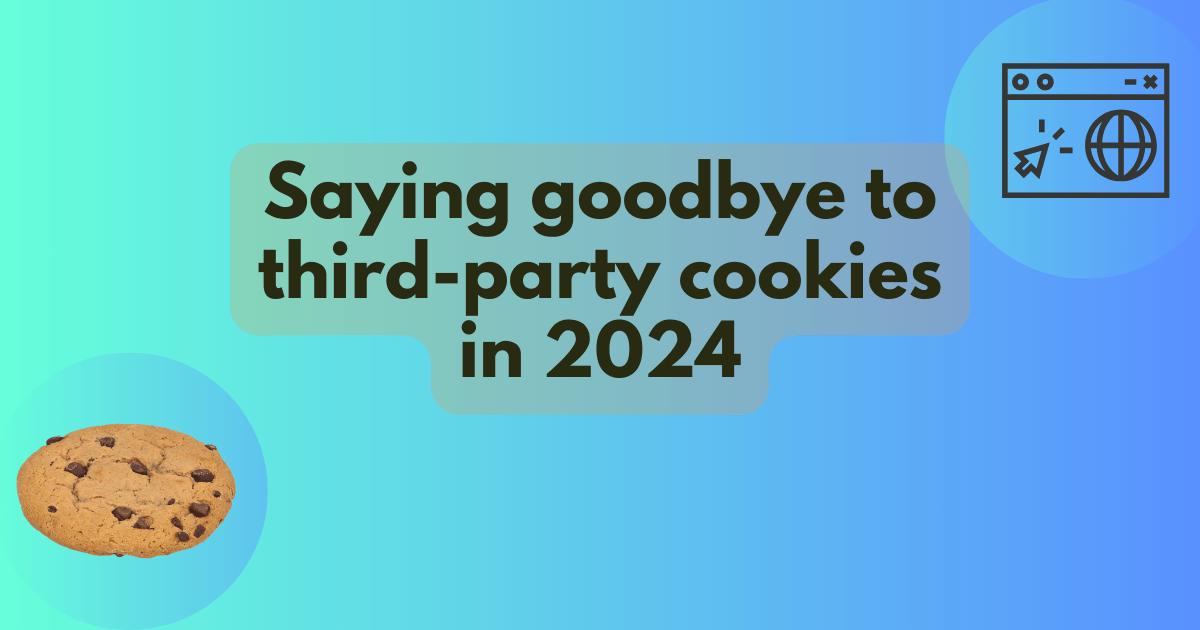Saying Goodbye to Third-Party Cookies in 2024: What You Need to Know
Third-party cookies have been instrumental in tracking user behavior, measuring ad performance, and targeting specific audiences. Without these cookies,

As we navigate the digital landscape of 2024, one major shift is taking center stage: the gradual elimination of third-party cookies. This change, driven by increasing concerns over privacy and data security, is reshaping the way businesses approach digital marketing and data collection. For many, saying goodbye to third-party cookies signifies the end of an era and the dawn of a new era of privacy-conscious marketing strategies. But what does this shift really mean, and how can businesses adapt to the evolving environment? In this comprehensive guide, we’ll explore the implications of this change and offer strategies to help businesses thrive in a cookieless world.
Understanding Third-Party Cookies
Third-party cookies have long been a cornerstone of digital advertising. These cookies are placed on a user’s browser by a domain other than the one they are currently visiting. They enable advertisers to track user behavior across multiple websites, creating detailed profiles for targeted advertising. For example, if you visit an online clothing store and then later see ads for that store on a news website, it’s likely due to third-party cookies.
While third-party cookies have facilitated personalized advertising and more efficient marketing campaigns, they have also raised significant privacy concerns. Users are increasingly aware of and concerned about how their data is being collected and used. This growing demand for privacy has led to increased scrutiny and regulatory action against the practices surrounding third-party cookies.
The Shift Away from Third-Party Cookies
The decision to phase out third-party cookies is not sudden but a response to evolving privacy standards and regulatory frameworks. Major web browsers like Google Chrome, Safari, and Mozilla Firefox have announced plans to block or limit third-party cookies, with Chrome, the most widely used browser, set to phase out these cookies by the end of 2024.
The shift is driven by several factors:
Privacy Regulations: Laws such as the General Data Protection Regulation (GDPR) in Europe and the California Consumer Privacy Act (CCPA) have set stringent standards for data privacy and transparency. These regulations require companies to obtain explicit consent from users before collecting and using their data, making third-party cookies less viable.
Consumer Demand: Users are increasingly concerned about their online privacy and are demanding more control over their data. This demand has pressured companies and regulatory bodies to address privacy concerns more effectively.
Technological Advancements: New technologies and methodologies are emerging that offer alternative solutions to third-party cookies. These solutions aim to balance the need for targeted advertising with the need for user privacy.
The Implications for Businesses
The elimination of third-party cookies presents both challenges and opportunities for businesses. Understanding these implications is crucial for adapting and thriving in the new digital landscape.
Impact on Digital Advertising: Third-party cookies have been instrumental in tracking user behavior, measuring ad performance, and targeting specific audiences. Without these cookies, businesses will need to rely on alternative methods to achieve similar outcomes. This may involve adopting first-party data strategies, leveraging contextual advertising, or exploring new technologies like machine learning and artificial intelligence.
Data Collection and User Consent: With the decline of third-party cookies, businesses will need to focus more on collecting first-party data—data that users willingly provide directly to the business. This requires transparent data collection practices and clear consent mechanisms. Building trust with users will be crucial in encouraging them to share their data willingly.
Personalization and Targeting: Personalization has been a key driver of digital marketing success. However, without third-party cookies, businesses will need to explore alternative approaches to deliver personalized experiences. This may involve using first-party data more effectively, leveraging behavioral insights, and adopting new technologies to understand user preferences.
Adapting Marketing Strategies: Marketers will need to adapt their strategies to the cookieless world. This includes rethinking targeting approaches, investing in new technologies, and exploring alternative advertising models. Businesses may also need to rethink their measurement and analytics strategies to ensure they can still assess the effectiveness of their campaigns.
Strategies for Adapting to a Cookieless World
As we move towards a cookieless future, businesses can take several steps to adapt and thrive in this new environment. Here are some key strategies to consider:
Invest in First-Party Data: Building a robust first-party data strategy is essential. Focus on collecting data directly from your customers through various touchpoints, such as website interactions, customer surveys, and loyalty programs. Ensure that your data collection practices are transparent and that you obtain explicit consent from users.
Enhance User Experience: Providing a seamless and personalized user experience can help build trust and encourage users to share their data. Invest in user experience (UX) improvements, create engaging content, and offer value to your users to foster positive relationships.
Explore Alternative Tracking Methods: Consider adopting alternative tracking methods, such as fingerprinting or contextual advertising. Fingerprinting involves creating a unique identifier based on a user’s device and browser characteristics, while contextual advertising targets users based on the content they are viewing rather than their browsing history.
Leverage Data Clean Rooms: Data clean rooms are secure environments where multiple parties can collaborate and analyze data without exposing individual user information. These environments can help businesses gain insights from aggregated data while maintaining user privacy.
Embrace AI and Machine Learning: Artificial intelligence (AI) and machine learning (ML) can offer valuable insights and help businesses understand user behavior without relying on third-party cookies. Invest in AI and ML technologies to enhance your data analysis and personalization efforts.
Build Strong Partnerships: Collaborate with technology providers, data platforms, and advertising networks to explore new solutions and strategies for the cookieless world. Building strong partnerships can help you stay informed about emerging trends and technologies.
Stay Informed and Adapt: The digital landscape is constantly evolving, and staying informed about industry developments and regulatory changes is crucial. Regularly review your data collection practices, marketing strategies, and privacy policies to ensure they align with the latest standards and best practices.
The Future of Digital Marketing
The shift away from third-party cookies marks a significant transformation in digital marketing. While it presents challenges, it also offers opportunities for innovation and improvement. Businesses that adapt to these changes by embracing new technologies, prioritizing user privacy, and building strong customer relationships will be well-positioned to succeed in the cookieless world.
As we say goodbye to third-party cookies in 2024, it’s essential to approach this transition with a proactive mindset. By focusing on first-party data, exploring alternative tracking methods, and investing in cutting-edge technologies, businesses can navigate the evolving digital landscape and continue to deliver valuable and personalized experiences to their audiences.
In conclusion, the end of third-party cookies is not the end of effective digital marketing. Instead, it’s an opportunity to redefine how we connect with users and build stronger, more trust-based relationships. Embrace the changes, stay agile, and continue to innovate as we enter this new era of privacy-conscious marketing.
FAQs
1. What are third-party cookies and why are they being phased out? Third-party cookies are tracking cookies placed on your browser by websites other than the one you're currently visiting. They are used to collect data about your browsing behavior across multiple sites to enable targeted advertising. They are being phased out due to growing privacy concerns and regulations such as the GDPR and CCPA, which emphasize user consent and data protection.
2. When will third-party cookies be completely removed from major browsers? Major browsers like Google Chrome, Safari, and Mozilla Firefox have announced plans to phase out third-party cookies by the end of 2024. This means that by late 2024, third-party cookies will no longer be available for tracking and targeting users.
3. How will the removal of third-party cookies affect digital advertising? The removal of third-party cookies will impact digital advertising by making it harder to track user behavior across multiple sites. Advertisers will need to rely on alternative methods for targeting and measuring ad performance, such as using first-party data, contextual advertising, and advanced technologies like AI and machine learning.
4. What is first-party data and how can businesses use it? First-party data refers to the information that businesses collect directly from their own customers or website visitors. This data is collected through interactions such as website visits, customer surveys, and loyalty programs. Businesses can use first-party data to personalize marketing efforts, improve user experience, and create targeted campaigns without relying on third-party cookies.
5. What are some alternative tracking methods to third-party cookies? Alternative tracking methods include:
- Contextual Advertising: Targeting ads based on the content of the web page rather than user behavior.
- Fingerprinting: Creating a unique identifier based on a user’s device and browser characteristics.
- Data Clean Rooms: Secure environments where aggregated data can be analyzed without exposing individual user information.
6. How can businesses ensure they are compliant with data privacy regulations in a cookieless world? Businesses can ensure compliance by:
- Obtaining Explicit Consent: Clearly informing users about data collection practices and obtaining their consent.
- Transparent Data Collection: Being transparent about what data is collected and how it is used.
- Adapting to Regulations: Staying updated with privacy laws and adjusting practices to align with new regulations.
7. What role does AI and machine learning play in the cookieless future? AI and machine learning can help businesses analyze data and gain insights into user behavior without relying on third-party cookies. These technologies can enhance personalization, optimize marketing strategies, and provide valuable data analysis to improve decision-making.
8. How should businesses adapt their marketing strategies in light of the third-party cookie phase-out? Businesses should:
- Invest in First-Party Data: Build and leverage first-party data for targeted marketing.
- Explore New Technologies: Use AI, machine learning, and other technologies to understand user preferences and behavior.
- Enhance User Experience: Focus on providing a personalized and valuable experience to encourage data sharing.
9. What are data clean rooms, and how can they benefit businesses? Data clean rooms are secure environments where businesses can collaborate and analyze aggregated data without exposing individual user details. They benefit businesses by enabling data sharing and analysis while maintaining user privacy, helping to derive insights and optimize marketing strategies.
10. How can businesses stay informed about changes in data privacy and digital marketing trends? Businesses can stay informed by:
- Following Industry News: Keeping up with developments in data privacy regulations and marketing trends.
- Engaging with Experts: Consulting with data privacy and marketing professionals.
- Attending Webinars and Conferences: Participating in industry events to learn about new technologies and best practices.
Get in Touch
Website – https://www.webinfomatrix.com
Mobile - +91 9212306116
Whatsapp – https://call.whatsapp.com/voice/9rqVJyqSNMhpdFkKPZGYKj
Skype – shalabh.mishra
Telegram – shalabhmishra
Email - info@webinfomatrix.com
What's Your Reaction?
















